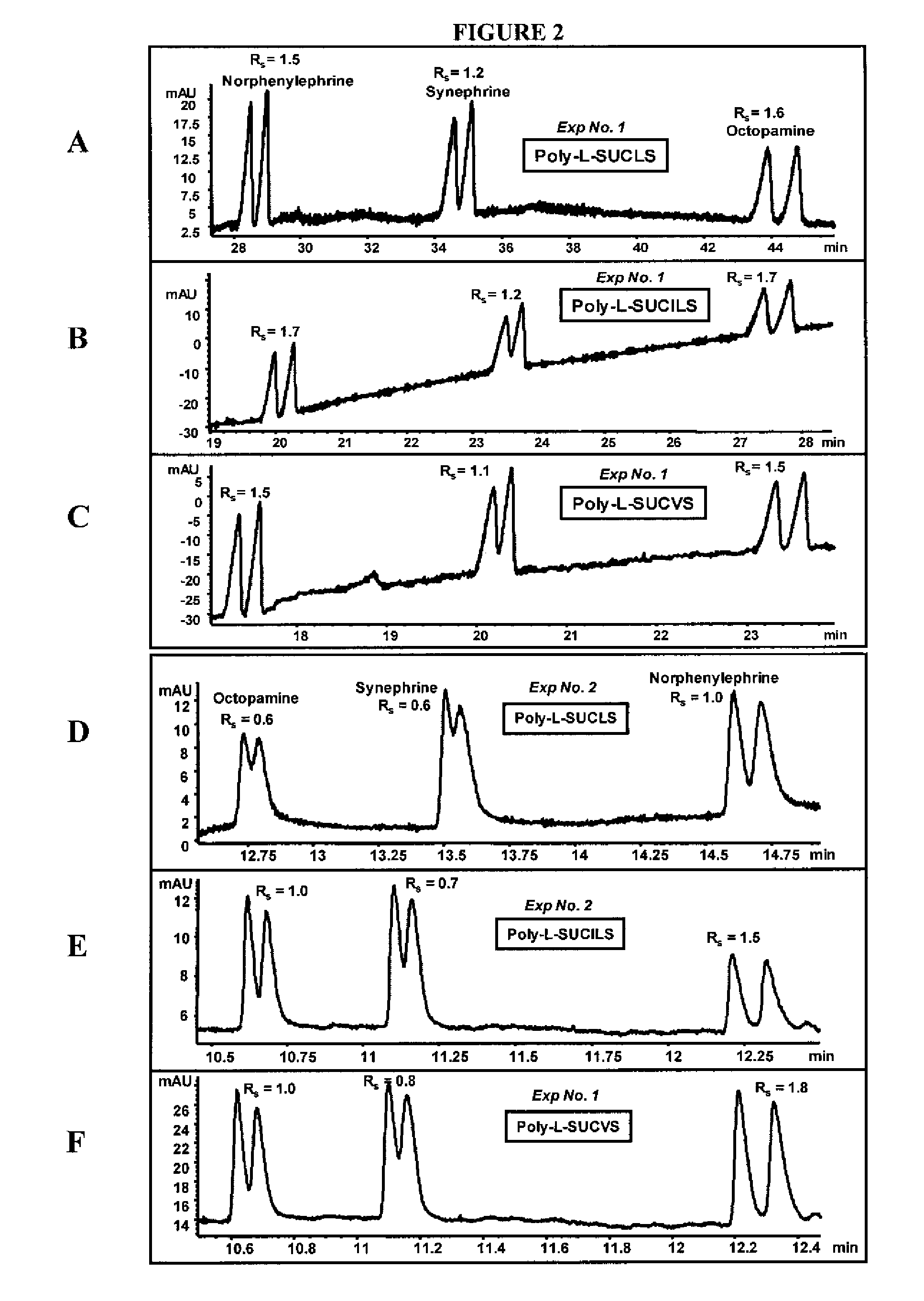Polymeric sulfated surfactants for capillary electrophoresis (CE) and ce-mass spectrometry (ce-ms)
a surfactant and polymer technology, applied in the field of sulfated micelle compositions, can solve the problems of generating heat that is deleterious to separation, affecting reducing the detection efficiency of sulfated micelle, so as to reduce the undetectable joule heating produced, improve the ms detectability, and generate considerable heat
- Summary
- Abstract
- Description
- Claims
- Application Information
AI Technical Summary
Benefits of technology
Problems solved by technology
Method used
Image
Examples
example 1
Characterization of the Physiochemical Properties of Monomers and Polymers of Sodium N-Undecenoxycarbonyl-L-amino Acid Sulfates (L-SUCAAS)
[0067] The physiochemical properties of the enantiomerically pure, synthetic sulfated amino acid surfactants sodium N-undecenoxycarbonyl-L-leucine sulfate (L-SUCLS), sodium N-undecenoxycarbonyl-L-isoleucine sulfate (L-SUCILS), and sodium N-undecenoxycarbonyl-L-valine sulfate (L-SUCVS) and their respective micelle polymers (poly-L-SUCLS, poly-L-SUCILS, and poly-L-SUCVS, respectively, collectively referred to as polysodium N-undecenoxycarbonyl-L-amino acid sulfates (poly-L-SUCAAS)) were determined and are summarized in Table 1.
[0068] Determination of CMC
[0069] The critical micelle concentration (CMC) was determined using a sigma 703 Digital Tensiometer (KVS Instruments USA, Monroe, Conn.), by the Du NoÜy ring method at room temperature. In this method, a platinum ring with defined geometry was immersed into a liquid and then carefully detached th...
example 2
Enantioseparation of Phenylethylamines
[0085] The ability of the micelles embodied herein to provide chiral separation and detect positively charged analytes was measured. The positively charged analytes were selected from three classes of phenylethylamines (PEAs): one with two hydroxyl groups (FIG. 1), another with one hydroxyl group (FIG. 2), and still another with no hydroxyl groups (FIG. 3). The enantiomeric resolution was measured at both a low pH (2.0-3.0) and a high pH (6.0-7.0) using sulfated polymeric surfactants.
[0086] Identification of Factors Maximizing Chiral Rs and Minimizing Analysis Time
[0087] Variables were identified which had significant effects on chiral resolution (Rs) and analysis time. A three-level four-factor well-balanced design from a Plackett-Burmann design (Analy. Chim. Acta 276, 189-95 (1993); Electrophoresis 26, 818-32 (2005)) was used to study the four most influential factors that maximize chiral Rs, and minimize analysis time (AT). The experimenta...
example 3
Application of Optimized MEKC-MS Conditions for Sensitive Pseudoephedrine Assay in Human Urine Sample
[0106] The applicability of the chiral polymeric sulfated surfactants provided herein were used in a quantitative chiral assay for one of the PEAs [e.g., (±)-pseudoephedrine] found in human body fluid. The enantiomer (1S,2S)-(+)-pseudoephedrine is the most commonly used over-the-counter cough medicine and often has been misused for its stimulant properties. (±)-pseudoephedrine also has been used as a precursor for the clandestine production of methamphetamine and related illicit drugs. The serum half-life of (±)-pseudoephedrine is 5-8 hrs and about one-half of the dosage taken is excreted in the urine.
[0107] Poly-L-SUCLS was used for the identification of the presence of (±)-pseudoephedrine in human urine and the limit of detection (LOD) was compared for both low and high pHs. A chiral MEKC-MS method development was performed on class III PEAs to obtain optimum sheath liquid and MS...
PUM
 Login to View More
Login to View More Abstract
Description
Claims
Application Information
 Login to View More
Login to View More - R&D
- Intellectual Property
- Life Sciences
- Materials
- Tech Scout
- Unparalleled Data Quality
- Higher Quality Content
- 60% Fewer Hallucinations
Browse by: Latest US Patents, China's latest patents, Technical Efficacy Thesaurus, Application Domain, Technology Topic, Popular Technical Reports.
© 2025 PatSnap. All rights reserved.Legal|Privacy policy|Modern Slavery Act Transparency Statement|Sitemap|About US| Contact US: help@patsnap.com



